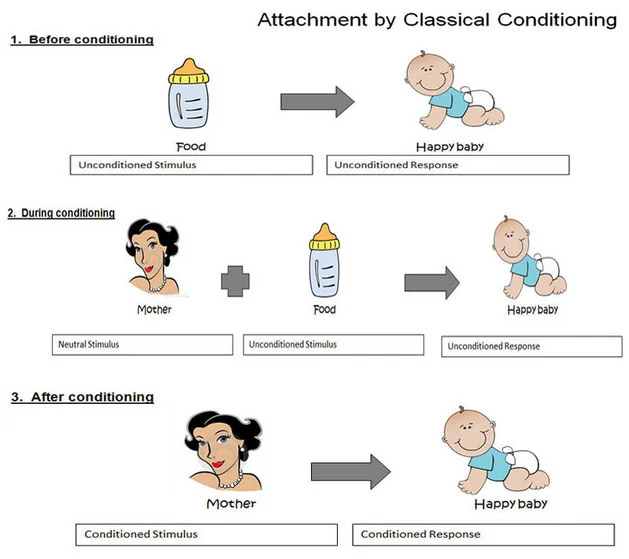explanations of attachments
1/8
There's no tags or description
Looks like no tags are added yet.
Name | Mastery | Learn | Test | Matching | Spaced |
|---|
No study sessions yet.
9 Terms
what is the learning theory explanation for attachments
Also known as cupboard love it argues that infants form attachments to there caregiver because they provide food.
classical conditioning
The child learns through classical conditioning by associating milk with the mother

positive reinforcement
is when a behaviour is made more likely by when by receiving a positive stimulus. In attachment when the baby cries the mother feeds it (get positive stimulus). so next time it wants food the baby is more likely to cry
negative reinforcement
when a behaviour is made more likely by removing an unpleasant stimulus. In attachment this occurs when the baby stops crying after its fed. The negative or adverse stimulus of crying is removed when the baby is fed. making the parent more likely to feed the baby next time it cries to remove the adverse stimulus
what is the secondary drive
Drives are desires to complete and action. primary drives are instinct eg eating or sleep. secondary drives are learnt and these help ultimately satisfy the primary drive. in this case an attachment is the secondary drive formed to for fill the primary drive of hunger
one strength is its face validity
The theory has high face validity in that it makes sense that those who provide food will also form the strongest attachments.
One strength is that whilst the theory of classical conditioning might not be 100% correct there are useful parts.
Whilst it may not be feeding that develops the attachment, parts of the theory could still be correct e.g. it is still credible that association (classical conditioning) between the primary caregiver and the provision of comfort and social interaction is part of what builds the attachment.
one limitation is counter animal studies
Animal studies have shown that food is not necessarily required for the formation of an attachment. For example, Lorenz showed that imprinting occurs before feeding and is maintained regardless of who feeds them whilst Harlow found that rhesus monkeys would form attachments based on contact comfort rather than on the person providing the food.
counter evidence from a study
Schaffer and Emerson showed that children tended to form a primary attachment with the biological mother even though it may have been other carers who provide most of the feeding.